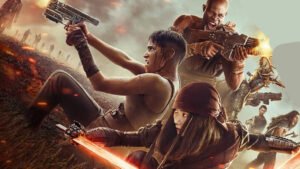Players will soon be able to join the fray in the world of Games Workshop’s Warhammer 40K universe with the release of Dawn of War III.
With that coming release, CGM reached out to the game’s director, Phillip Boulle, to learn about how player customization will let players really make armies their own with using colour choices and unit choices, and how a deep love of the lore helped them choose the towering metal giants, brutish monsters, and heavy drop pods that would enhance this new entry in the series.
CGMagazine: What drew you to the Warhammer series?
Phillip Boulle: I’ve been a fan for coming on 30 years now. I played when I was a kid and in college. I made the minis back then. When I became a game dev, I kept up my interest, and I came to Relic to work on those types of games.
I came to Relic 10 or 11 years ago to work on what became Dark Crusade, which was one of the expansions for the original Dawn of War. Then, I worked on Dawn of War II and its expansions and Space Marine, and, here I am (laughs). I have a deep, deep affection for 40K.
CGM: What sort of work goes into incorporating all the lore and vehicles and other aspects into interesting units for an RTS?
Boulle: In some ways, it’s really easy because they make really gorgeous models that capture a really exciting fantasy with the crazy Ork contraptions, the sleek Eldar tanks, or Drop Pods and heavy Space Marine stuff. In some ways, a lot of the up-front design work is done for us, visually. The big challenge is in making sure it works well in a 3D environment where things are moving—that they animate well, and that the things you don’t see on the tabletop come to life—so audio, visual effects, etc.
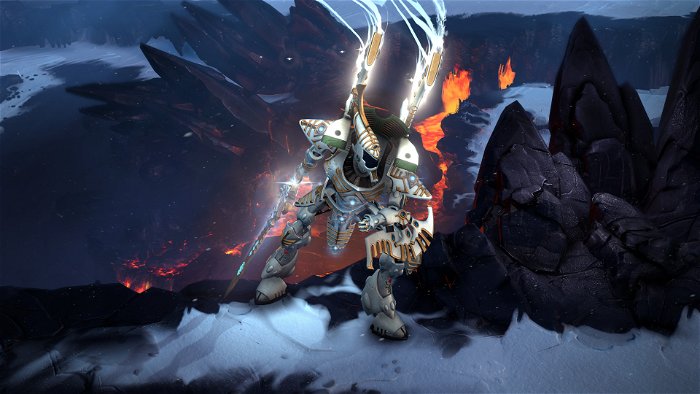
Then, from a game design standpoint, it’s making sure it stands as its own game. We’re not just trying to mimic the tabletop. We’re trying to capture the essence of the fantasy that the property brings. The way we think about it is that both the tabletop and Dawn of War are trying to echo the fantasy that you see in Games Workshop artwork or in their novels and so on. We’re both expressions of that core fantasy.
CGM: What steps do you take to ensure you stay different from the tabletop?
Boulle: The game itself is fundamentally different—it’s a real-time experience as opposed to a turn-based experience. We don’t have a lot of randomness in our game. It comes down to a lot of precision movement, whereas a tabletop game relies on dice.
In some ways, just the inherent differences push us apart. Take a look at a unit like Jain Zar, who’s this Eldar demigoddess. She’s got this tri-bladed thing and this giant spear, and she’s really fast. In the tabletop, that does certain things, but we sit down and ask what would be an interesting for it to do in our game ecosystem. We come up with a thing like the boomerang throw and the charge, and how those interact. There aren’t one-for-one relationships with what’s on the tabletop, but they come from the same essence.
CGM: How do you decide what to put in for elites? When you want to put a big, special unit in the game for fans of the tabletop and series?
Boulle: We go through a prototyping process. We’ll go through the codexes and the lore, and look for stuff that might be interesting as elite units. Then, we go through a paper design process, then prototype them, playing them as much as we can until we hone and refine the things that are fun.
We look for units that will stand out, that don’t necessarily have the same profile as the line units. Space Marines in particular, but this is also true of Orks. Many of the basic units are the same fundamental guy or creature with different weapon sets. So, we look for things that push out of that, be it terminators or giant robots or big single heroes.
Definitely, the story we were trying to tell with the campaign also influenced our choices, because we wanted all of the signature characters from the campaign to show up as elite heroes. We also make sure each faction has enough of each different type. You don’t want one faction to feel overly weighted one side or another because it is a competitive game, after all.
CGM: What thoughts went into creating the play styles for each of the three factions?
Boulle: One of the big things we wanted to do with Dawn of War III was double down on the factional character. One of the great strengths of the 40K IP is that each of these armies are really different. They have a different fantasy behind them, they have lots of unique lore about them, and we wanted to play with that pretty heavily.
With the Orks, we’ve always captured the sort of fun brutality of them before—the sort of hoolligan-ness of them. This time, we really wanted to take that and give them a unique twist, which was the scrapping and looting mechanics, the Waaah towers, that momentum-building gameplay. With the Eldar, we wanted to play up the mobility, the hit and run tactics.
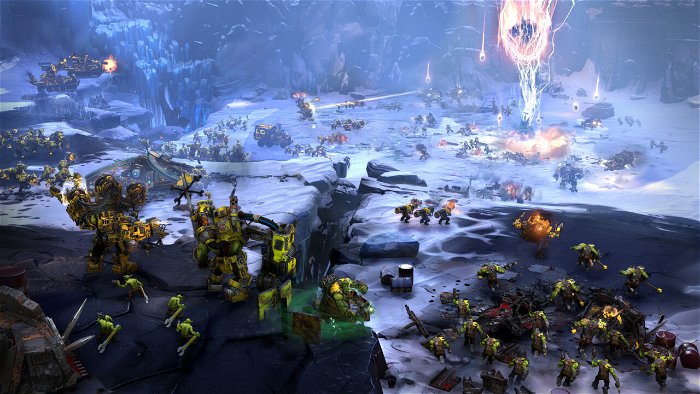
With the Space Marines, we made drop pods more important than we’ve ever made them before. Space Marines really have the best tide-turning abilities in the game. They can go from losing a fight to winning a fight very quickly because of various abilities they have.
It’s all about echoing the fantasy. We wanted to create something that was compelling and engaging to players who didn’t know 40k or only had a passing familiarity with it. We also wanted to show the love to the people who came with a pre-existing love for that fantasy. We wanted them to feel like “This is how the Orks really should have been all along.” and so on.
CGM: Is it an important aspect to give players those special tide-turning moments in each match? To have those large wins and victories that they tell stories about afterwards?
Boulle: Yes, absolutely. From a gameplay standpoint, we definitely wanted to avoid the ‘dead man walking’ scenario where you lose an early engagement in a match and know you’ve lost the match, but it’s going to take another twenty minutes for it to happen. So, we wanted to create those abilities to come back.
Doing so also really creates those possibilities for a social story. We actually enshrined it as “getting to the ‘f**k yeah!'”, that moment where you stand up from the computer and you’re like “Yeah! I did it!”. I think those are very important on both sides of the equation. Even when you’re losing, having some intermediary goals that you can go after.
So, the super units are my favourite example of this. They’re these giant robots, they’re these late game units that are super powerful, but they’re not invulnerable. Typically, the first person who gets them out is the person who’s got some sort of push. They can definitely turn the tide, but even if you’re on the losing side, I’ve had some of the most fun, even losing the overall match, but managing to take down someone’s super unit.
That’s the thing with competitive games like this. You want that sense that you still had fun. If you lost, you want to come back. Part of that is the strategic desire to come back and do better, trying new strategies to figure it out, but also, you want some of those moments that you can tell stories about.
CGM: Is it hard to create that moment-to-moment feeling of, not necessarily victory, but feeling that the player is always having fun? These moments that are special even if the player doesn’t win the overall match?
Boulle: It’s definitely challenging to make a game that has those comeback moments—that really exciting moment-to-moment gameplay—but still has that strategic depth. It’s not like you lose a fight and it has no impact, you want there to be a cost to doing well, a benefit to doing well, and yet, still have those moments where the momentum can shift and people can get that thrill there.
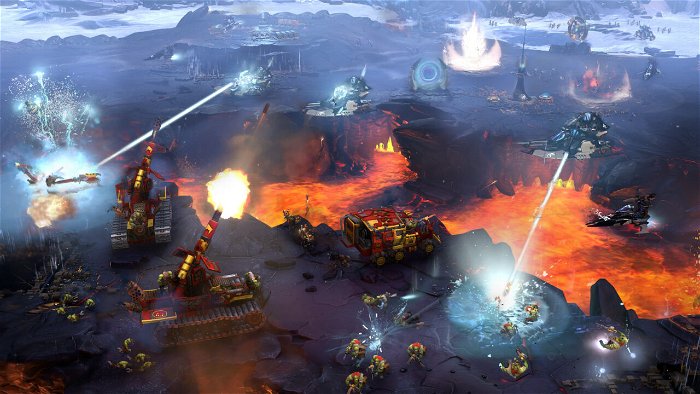
It’s the goal we set from the very first days of the project. Our major pillar has always been what we call “spectacular battle”. That’s not just that it looks full of spectacle, but that the gameplay and the spectacle line up. You see really amazing things, or you hear really amazing things when you execute your will. If there’s a bright space laser on-screen, it’s because you put it there.
Using that as the guiding principle for many of our gameplay decisions has gotten us to where we have that balance of strategy and visceral moment-to-moment fun.
CGM: With doctrines and selectable elites, what were your thoughts in making the three factions extremely different based on player choices?
Boulle: The inspiration came from the tabletop in that you make every choice under the sun. Knowing that we wanted to get there, we then experimented with a variety of ways to do that.
Taking the heroes that were more inspired by Dawn of War II and the army that was more inspired by Dawn of War, we saw how well those meshed together. Then, we realized we could swap out those heroes and that would really help. The doctrines became a secondary way to enhance the possibilities without eclipsing the heroes.
We just really wanted you to get that match-to-match experience of refining your strategy – that sort of pre-match experience being part of the equation.
CGM: Will there be many options available for custom paint jobs?
Boulle: There’s a full army painter where you can make your own custom colours. You have something in the order of twenty pre-sets for each faction, and then you can make your own. I paint miniatures, so I wanted to see that. That’s also been part of Dawn of War since the beginning.
For the elites, that depends upon the elite. Gabriel Angelos is always going to look like a Blood Raven, but he does have some trim elements that will change colour. Some of the others, like the Terminators, will fully change colour based on your choices.
It’s part of expressing who you are in the game. “I don’t want to play my Black Templars, I want to play my Ultra Marines. I want to play my Pink Froo-Froo Marines.”. That’s great! You can make all kinds of choices there.
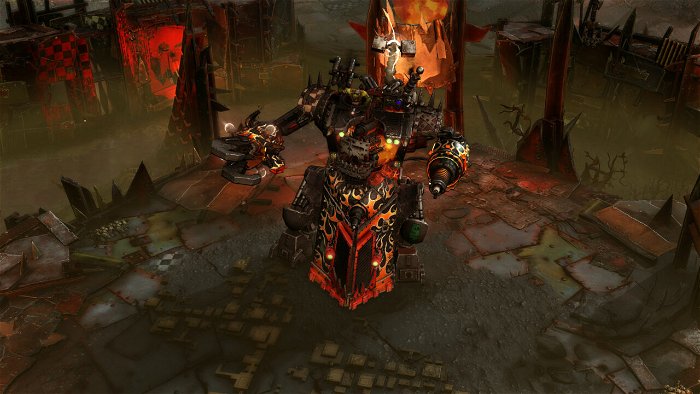
CGM: What other customization options did you consider? Any that got cut?
Boulle: During the production process, a lot of the work was figuring out where we were going to put that customization. We experimented with allowing you to swap out the entire army. Really make the choice of what units you were going to bring in.Although there were some fun aspects
Although there were some fun aspects about it, it also opened up a lot of risk of screwing yourself before you went in to play. It also took away some of the on-the-moment decision making that’s part of an RTS experience. It felt like there were too many times when you would want to react one way, but you had closed off those options before the match began. That’s how we ended up with the line units that were consistent and then the heroes that swap out.

